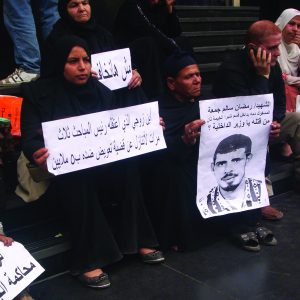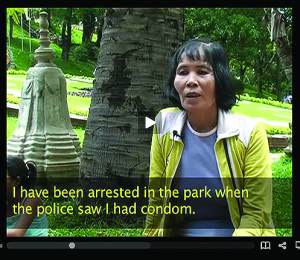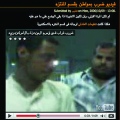TACTIC 10: VIDEO
REVEAL THE TRUTH
investigate and expose
download this tactic card (pdf 804kb)
watch the full video
THIS TACTIC IS USEFUL WHEN YOU ARE ABLE TO COLLABORATE WITH OTHERS TO IDENTIFY, SHARE AND ACT ON EVIDENCE THAT IS BEING CONCEALED FROM THE PUBLIC OR IGNORED BY THOSE WHO NEED TO ACT
EXAMPLES FROM THE VIDEO
|
|
By citizens/journalists in Egypt Journalist Noha Atef created TortureInEgypt.net to document human rights abuses committed by police against Egyptian citizens, using photos and videos submitted by readers. In some cases, the videos are shot by the police themselves. Noha also follows up on accounts of unlawful imprisonment and police corruption sent in by readers. After she drew local media attention to her stories, an innocent man who had been jailed for 14 years was released from prison.
TOOLS USED: Drupal for creating the website (before that, Blogspot), photos and videos, usually shot on and sent from mobile phones.
LINKS TO LEARN MORE: |
|
ASTRUBEL |
By advocates in Tunisia Tunisian bloggers collaborated on a mapping project that revealed the presidential plane was being used for extensive personal travel. Their campaign began when a blogger, Astrubal, discovered images of the Tunisian president's plane on websites devoted to tracking air traffic. Using this data, Astrubal combined the plane photos with a visualisation created using Google Earth to show which airports the plane had been seen at and when. The video spread on YouTube, which led to the mainstream media investigating further. As a result, the issue of misuse of public property by government officials received much attention, but as another consequence the Tunisian government blocked YouTube and another video sharing site, DailyMotion.
TOOLS USED: Planespotters’ websites (like Airliners.net) Google Earth, YouTube, Flickr.
LINKS TO LEARN MORE: |
TACTIC 10: PLAN YOUR ACTION
REVEAL THE TRUTH
investigate and expose
download this tactic card (pdf 804kb)

WWW.TORTUREINEGYPT.NET
Plan your action
- If you don't yet have access to all the data you need to prove abuse or corruption, your campaign can start by presenting available data and posing some questions to readers or public officials. This can inspire others to carry out further investigations.
- Some campaigns must rely on reports and testimonies submitted anonymously, but sometimes you might be given direct access to people closely involved in an issue. Both types of testimony carry risks for the people sharing their stories. Think about how to protect your sources: their names and locations, but also their IP addresses, email addresses, or identities on social network sites.
- Once your reports, videos, or stories are picked up and republished by others, that attention can bring in new information which adds to your original story. You will need to track how your media spreads and what coverage it receives, and plan how you will use new information as it becomes available.
- In Egypt, where police themselves used mobile phones to exchange videos of abuse they perpetrated, advocates were able to get access to those videos and publish them online. How can you design your campaign to take advantage of existing documentation that you can republish?
Do it yourselfAsk
- Is your campaign focussed on producing one piece of media – such as a video or a mash-up – or on giving regular updates using a blog or website?
- Is the media your campaign produces connected to a one-time event, or an ongoing issue?
- How can you involve your group in gathering facts and collecting testimonies?
- In what ways will you respect the safety and, if needed, anonymity, of those who give your campaign reports, testimonies, and sensitive data?
- Who are your allies in the mainstream media and among other rights organisations that can help you spread a story to a wider audience? How will you target them and what action will you ask them to support?
- What backup plan do you have to keep your data safe and secure if your computers, hard drives, or servers are seized?
Different ways you can do this
- If you want to make a video but don’t have enough video footage available, search Flickr, Google Images, or Wikipedia for open-licensed photos available for remix and reuse, and use them to edit into a video with music or a voiceover.
- For campaigns where total anonymity is not necessary, you can crowd-source the gathering of images, stories, and videos for your campaign by using a wiki – a page you can give anyone permission to edit. You should always carefully consider how you will verify information where necessary to ensure people and events are not wrongly portrayed.
- If video testimony from witnesses or survivors of rights abuses is very sensitive, you may not want to release your video online. You can instead arrange closed screenings to rights groups or to key people and organisations with influence.
- Not all campaigns need a mass audience – finding the right audience matters more. You can mobilise the power of a small, passionate audience, and take your findings to key policy-makers or the press later.
- Humour, surprise and popular culture can help you reach a wider audience. You can use cartoons and street art to convey your findings in a direct way and to get your message to those without internet access.
|
FEATURED TOOL Encrypt your email Keeping communications secure can be essential to protecting your sources and witnesses. Encrypting email can be difficult, but if you use webmail programmes like Gmail, Yahoo Mail, or SquirrelMail in your work, you can use the web browser plugin FireGPG. FireGPG will encrypt your email without your to having to leave the browser. It is available in over 25 languages. In order to use FireGPG you must first install GPG on your computer and create a key, a unique identifier that allows you to encrypt and share your communications securely. Tactical Tech’s Security in-a-box provides more detailed instructions on this and other security software. |
TIPS DALE KONGMONT FROM APNSW, ON COLLABORATION: "It’s important to work closely with human rights groups and others to get your message out more widely, but at the same time it is important to try to make sure key people hear you. We arranged for some senior UN staff to watch our video at the International AIDS Conference in 2008. People said they didn’t really understand how serious the police abuses we were reporting were until they saw the video, which gave them the incentive to take action."
SAMI BEN GHARBIA FROM GLOBAL VOICES, ON ENGAGEMENT: "The ability to access information online is in itself a power. But you also need to fill the gap between online and offline activism. If you are unable to reach audiences that do not have access to the internet, you need to find other ways to disseminate information offline: using USB memory sticks, DVDs, CDs, posters, flyers and other tools. Finding ways to bridge online and offline activism is critical."
NOHA ATEF FROM TORTUREINEGYPT.NET, ON BLOGS: "Blogs are a good tool in info-activism because they are easy to use, they don't require a broad technical knowledge, and they are free and quite popular, especially in the Arab world. They can be really effective at making change, especially when they establish credibility and respect among a large number of readers or even among a small audience with influence." |
TACTIC 10: CASE STUDY
REVEAL THE TRUTH
investigate and expose
download this tactic card (pdf 804kb)

APNSW
Case Study
| TITLE: WHO: WHERE: WEBSITE: |
Caught Between the Tiger and the Crocodile Asia Pacific Network of Sex Workers (APNSW) & Women’s Network for Unity (WNU) Asia Pacific region, focused in Cambodia APNSW |
DESCRIPTION
Members of the Asia Pacific Network of Sex Workers (APNSW) used digital video to document abusive conditions and human rights violations reported by sex workers detained in so-called 'rehabilitation' centres in Cambodia. While local media and politicians claimed that these centres were set up to teach vocational skills, sex workers interviewed after their release and escape told personal stories of assault, rape, and denial of access to clean food, water, and medicine. "We worked with a local APNSW member group, Women’s Network for Unity (WNU)," says Dale Kongmont, a member of APNSW and the producer of the video. "The people we interviewed are members of WNU and we have worked with them for many years. We explained to them what the video is about, and some of those who wanted to help fight the law directly agreed to the on-camera interview." APNSW posted the video on YouTube and blip.tv, and presented it at a day of action for 500 sex workers in Phnom Penh. Dale says, "One of the two centres was closed because of combined efforts of APNSW, WNU, and local human rights groups working together to provide evidence of the abuses that took place."
| TOOLS USED: | Flip video cameras, digital video editing software (Final Cut Pro), blip.tv, YouTube, website. |
| REACH: | Video launched at the International AIDS Conference in 2008. The target audience at the AIDS conference was UN agencies, but the video was shown to several thousand people during the event. The video has received over 3000 views on YouTube and blip.tv |
| RESOURCES: | Local partners to host a Day of Action and implement a media campaign, attendance at conferences to show video to policy-makers, video training from WITNESS. |
| TIME: | Just under one year to collect footage and edit, with two weeks of training from WITNESS. |
LEVEL Of DIFFICULTY: 2 out of 5
COST: USD$15,000 (with USD$7000 for staff, USD$5000 for production)
LINKS TO LEARN MORE:


